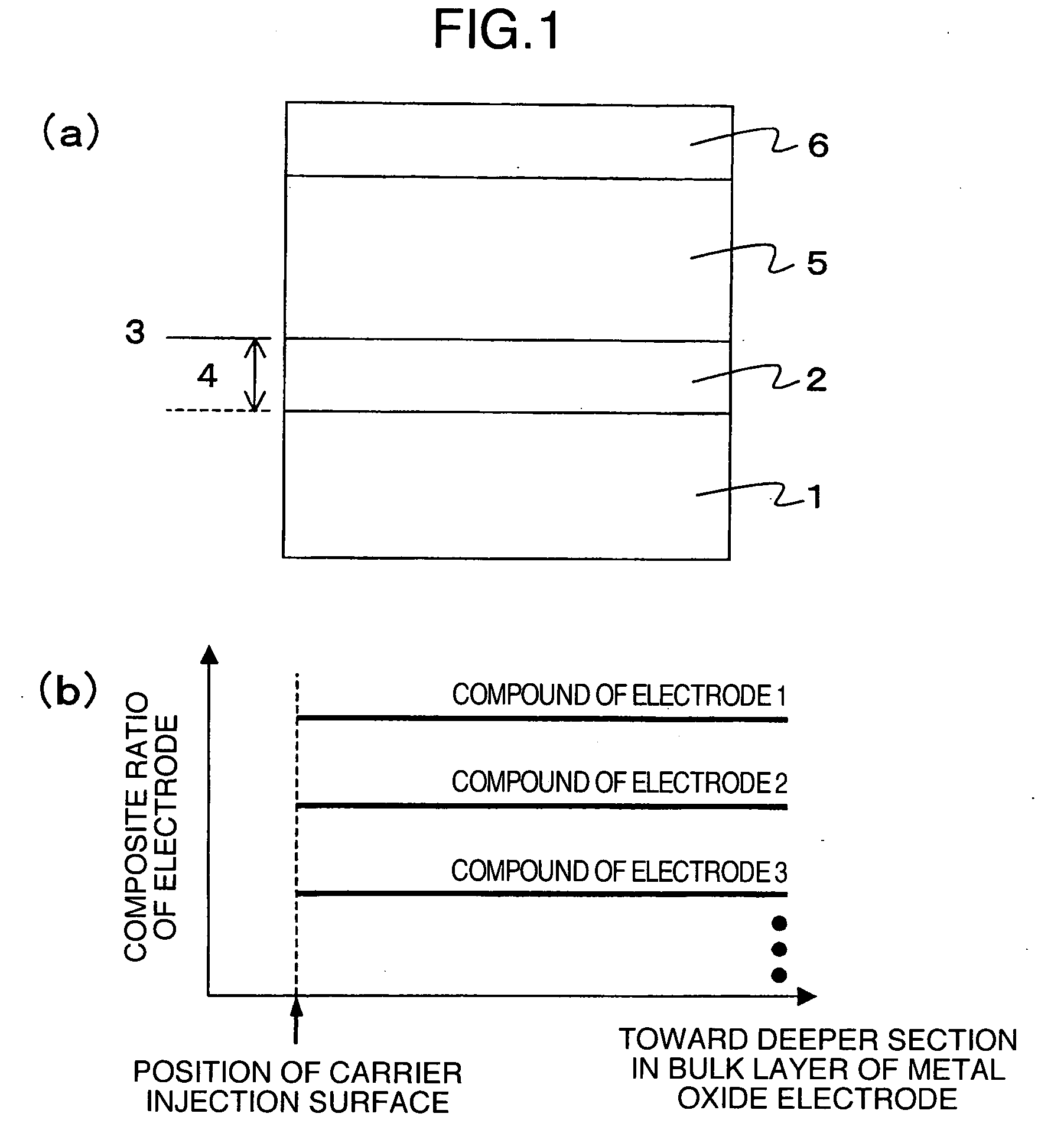Organic electroluminescence device and organic electroluminescence system
- Summary
- Abstract
- Description
- Claims
- Application Information
AI Technical Summary
Benefits of technology
Problems solved by technology
Method used
Image
Examples
example 1
[0151] First, description will be made of the basic structure of an organic electroluminescence device according to the present invention.
[0152]FIG. 1(a) shows the basic structure of the organic electroluminescence device according to the present invention. The organic electroluminescence device is formed on a substrate (1). By way of example, a metal oxide electrode (2) is formed immediately above the substrate (1).
[0153] A thin film layer (5) containing an organic substance is formed on the metal oxide electrode (2). A second electrode (6) different from the metal oxide electrode (2) is formed on the layer (5).
[0154] The organic substance-containing thin film layer (5) is shown as a single layer in FIG. 1(a) for simplicity. In reality, however, it may be formed as a multi-layered structure consisting of various thin films (such as an organic thin film, an inorganic thin film, and an organic-inorganic composite thin film) as known in many organic electroluminescence devices.
[01...
example 2
[0256] Next, description will be made of the results of the examinations similar to those in Embodiment 1 for an organic electroluminescence device including a different organic substance-containing thin film layer.
[0257] Embodiment 2 employed a device made of two organic layers, αNPD and Alq3, selected as a device including a simpler organic substance-containing thin film layer. Both of the used αNPD and Alq3 were products manufactured by Nippon Steel Corporation. A metal oxide electrode and surface treatment thereof were the same as those in Comparative Example except that plasma treatment 1A was performed on ITO-H.
[0258] The device was formed by putting αNPD with a thickness of 50 nm on the metal oxide electrode in the same manner as in Embodiment 1, putting Alq3 with a thickness of 50 nm thereon, putting a second electrode (LiF 0.5 nm, Al 150 nm) similar to that in Embodiment 1, and finally sealing them.
[0259] Table 3 shows the results of the evaluations of the emission charac...
example 3
[0265] Next, description will be made of the results of the estimations of the -optimal range of the composite ratios of the metal oxide electrode according to the present invention with reference to Table 4 shown below. Table 4 again shows the composite ratios of the elements In and Sn in the metal oxide electrodes ITO-H and ITO-A in Tables 1 and 2.
TABLE 4com-sputter time (min)positemetal00.5124ratiooxidetreat-depth (nm)averageshift atelectrodement00.751.536of 1-4surfaceITO-H1A15.0215.1414.9314.9714.8314.910.721B10.2613.5114.3514.0713.6914.03−26.921C8.8012.3612.7513.6913.7513.39−34.30ITO-A1C16.7214.6814.0013.4813.7313.7421.721B16.6114.5514.0013.3013.7213.6721.51
[0266] In Table 4, metal oxide electrodes having various composite distributions are provided by combining metal oxide electrodes and surface treatment types as desired. The composite ratios are substantially uniform when the sputter time is long, that is, in a deeper section in the bulk layer of the metal oxide electrode....
PUM
 Login to View More
Login to View More Abstract
Description
Claims
Application Information
 Login to View More
Login to View More - R&D
- Intellectual Property
- Life Sciences
- Materials
- Tech Scout
- Unparalleled Data Quality
- Higher Quality Content
- 60% Fewer Hallucinations
Browse by: Latest US Patents, China's latest patents, Technical Efficacy Thesaurus, Application Domain, Technology Topic, Popular Technical Reports.
© 2025 PatSnap. All rights reserved.Legal|Privacy policy|Modern Slavery Act Transparency Statement|Sitemap|About US| Contact US: help@patsnap.com



